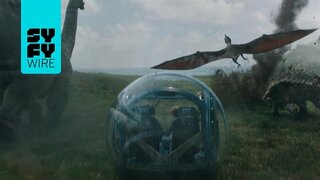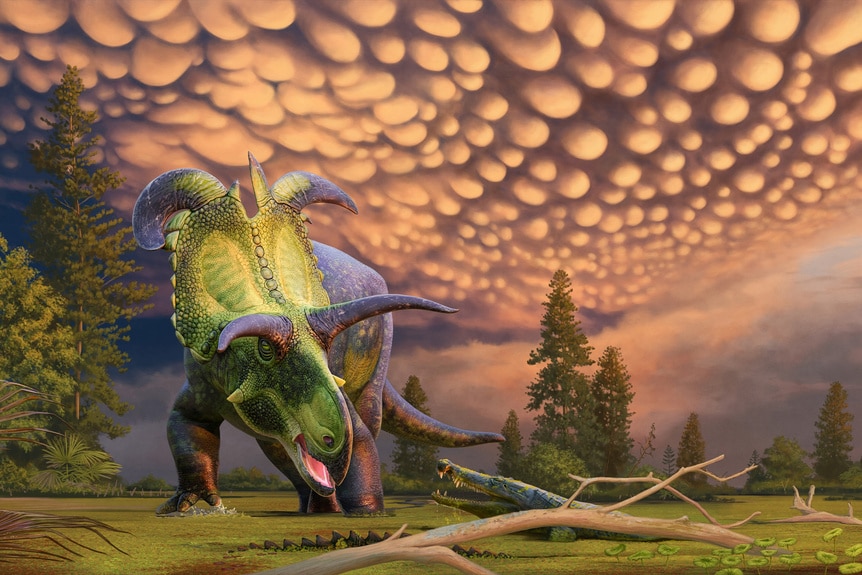Create a free profile to get unlimited access to exclusive videos, sweepstakes, and more!
Newly Discovered Horned Dinosaur Lokiceratops Named for Norse God and Marvel Character
This is what peak ceratopsian looks like.
John Hammond’s original idea for Jurassic Park started simply enough. Biological engineers would use emerging genetic tools to recover DNA from long dead animals and bring them back to life. InGen’s biggest problems at first, and the ones which would get them into all sorts of trouble, were corporate espionage and a heavy dose of hubris.
Later, the folks in charge of the resurrected dinosaur theme park, Jurassic World, would get into even bigger trouble by playing fast and loose with saurian genomes. Theme parks demand bigger and better attractions to keep attendees pouring in, and when it comes to a park like Jurassic World, that means new dinosaurs.
While the scientists at InGen were busily mashing DNA together to come up with newer, weirder, and more profitable dinosaurs, all they really needed to do was keep digging. Recently, paleontologists uncovered a new species of horned dinosaur sporting some of the weirdest headgear in history, buried in the badlands of northern Montana. The animal’s strangely curling horns earned it the name Lokiceratops rangiformis, in honor of the similarly adorned Norse god and Marvel character, Loki. The discovery was published in the journal PeerJ.
For More on Dinosaurs:
Largest Raptor Tracks Ever Found Hint at Monster-Sized Species
Reconstructing the Voices of Dinosaurs: The Science Behind Jurassic Park III
How Smart Were Rexy and her Tyrannosaur Friends? Scientists Disagree
Meet Lokiceratops, One of the Weirdest (Coolest) Horned Dinosaurs Ever Discovered
A partially complete skeleton was uncovered just a few miles south of the U.S.-Canadian border, but 78 million years ago it was a coastal paradise. Lokiceratops grew up in the forested swamplands of Laramidia, an ancient continent made up of what is now western North America.
Researchers recovered the bones from their resting place in a Montana quarry and took them back to the lab for cleaning and preparation. The skeleton is only partially complete, consisting of some hip bones (including one which is unique to the species), some shoulder bones, and fragmented bits of the head. Despite the missing pieces, preparators were able to reconstruct the skull because they had each part from at least one side of the head or the other. They filled in the gaps by recreating the missing pieces and correcting for things like compressive distortion caused by the weight of the Earth pressing down on the bones for millions of years.
The reconstructed skull reveals two massive horns coming off the back of the frill. They curl back and under, more like the horns of a ram than those of a typical horned dinosaur. There are two smaller spiked horns in the middle, jutting up and back. The frill is also ornamented by a series of eight smaller horns on either side. Finally, Lokiceratops had two large front-facing horns over the eyes. It spent its days in swamps and marshes, chowing down on rough woody plant material and looking awesome.
About 100 million years ago, the continents were in a different orientation. The Americas had already separated from Eurasia and what is now North America was undergoing a period of turbulent tectonic activity. During this period, the Rocky Mountains were born and as they rose into the air, the nearby land warped downward. Water crept in from the north and the south, eventually merging and creating the Western Interior Seaway, a body of water connecting the Gulf of Mexico to the Arctic Ocean and cutting North America down the middle.
On the east was a continent known as Appalachia and on the west was Laramidia, where the horned dinosaurs ruled. It was the domain of Triceratops, but that wouldn’t be until the end-Cretaceous, about 69 million years ago.
Lokiceratops lived 78 million years ago and never met Triceratops, but they might have been friends, or at least might have tolerated one another. The eastern coast of Laramidia at the time appears to have been a time of plenty, supporting a surprising number of large horned dinosaurs. Lokiceratops lived in a valley between the Eastern Interior Seaway and the mountains to the west. Previously, paleontologists thought there could be only two species of horned dinosaurs coexisting at the same time, but recent discoveries including Lokiceratoprs prove that isn’t always true.
Conditions were so favorable for this type of animal that there were at least five ceratopsian species all living in the same place at the same time. It’s possible there was just so much food available that they didn’t really have to compete for resources, and because they were so large they didn’t really have to worry about predators. Instead, the genetic race became about physical attraction.
In this dinosaurian Eden, Lokiceratops used its beak-like mouth to pull branches into its maw before chopping them to bits with its crushing teeth. While there was plenty of food to go around, ceratopsians were relatively isolated and didn’t really migrate. That isolation may have driven rapid evolution, with some species persisting no more than 100 - 200 thousand years, before dying out or speciating into something else. And much of that speciation was probably driven by sexual selection.
The preferences of mates drove rapid changes in head frills and horns, resulting in a wide array of ceratopsian headgear. They turned evolution into fast fashion and became some of the most stylish animals to ever walk the Earth. There is some comparison to be made between the ornamental headgear of ceratopsians and the impressive feather displays of peacocks and some other birds. Although, importantly, there’s no evidence of sexual dimorphism in horned dinosaurs. When it comes to ceratopsians, at least, even the hens get gussied up.
The fossilized bones of Lokiceratops have been mounted in a custom-built stand and are permanently housed at the Museum of Evolution in Maribo, Denmark. A reconstruction of the skull and a full-sized sculpture of the head (pictured above) are on display at the Natural History Museum of Utah in Salt Lake City, Utah.
Get Jurassic Park (and the entire Jurassic franchise) from Universal Pictures.
































